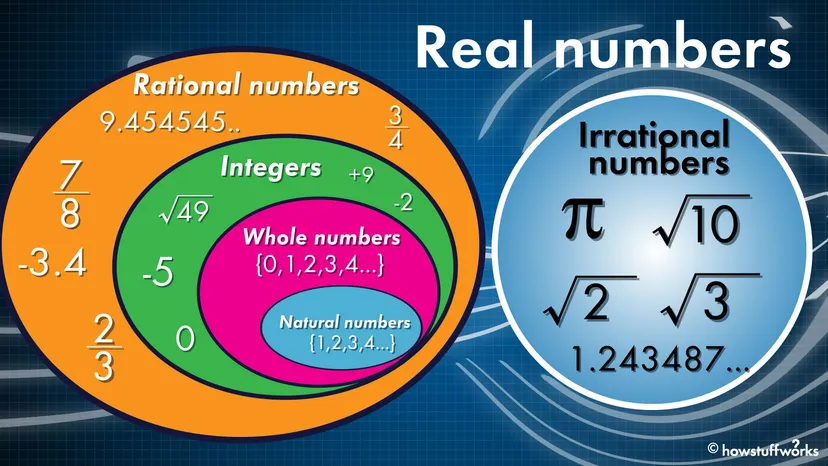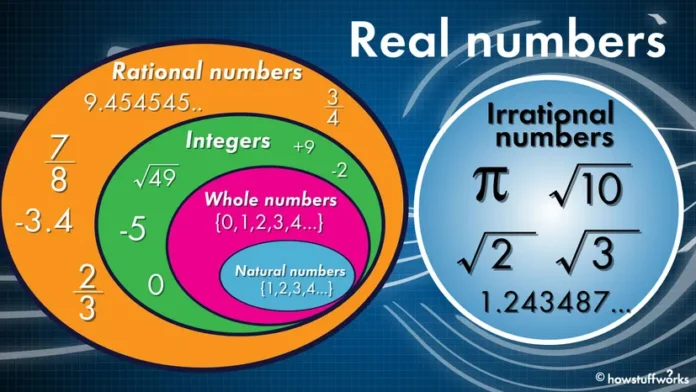In mathematics, the Number System is the study of different types of numbers, the operations performed on them, and their interrelationships. Let’s understand it step-by-step:

🔹 Types of Numbers
- Natural Numbers (N)
- Used for counting.
- Only positive numbers.
- Example: 1, 2, 3, 4, 5, …
- ⚡ Note: 0 is not a natural number.
- Whole Numbers (W)
- Natural numbers including 0.
- Example: 0, 1, 2, 3, 4, 5, …
- Integers (Z or T)
- Whole numbers and their negatives.
- Example: …, -3, -2, -1, 0, 1, 2, 3, …
- Classifications:
- Positive Integers: 1, 2, 3, …
- Negative Integers: -1, -2, -3, …
- Zero is neither positive nor negative.
- Even Numbers
- Divisible by 2 without remainder.
- Example: 2, 4, 6, 8, …
- Odd Numbers
- Not completely divisible by 2.
- Example: 1, 3, 5, 7, …
- Prime Numbers
- Exactly two distinct divisors: 1 and the number itself.
- Example: 2, 3, 5, 7, 11, …
- ⚡ Note: 2 is the only even prime number.
- Composite Numbers
- More than two divisors.
- Example: 4, 6, 8, 9, 12, …
- Co-Prime Numbers
- Two numbers whose only common divisor is 1.
- Example: 15 and 16.
- Rational Numbers (Q)
- Expressed in the form pq\frac{p}{q}, where pp and qq are integers and q≠0q \neq 0.
- Example: 35\frac{3}{5}, −72\frac{-7}{2}, 4 (since 4 = 41\frac{4}{1}).
- Irrational Numbers
- Cannot be expressed as pq\frac{p}{q}.
- Example: 2\sqrt{2}, 5\sqrt{5}, π\pi.
- Real Numbers (R)
- Combination of Rational and Irrational numbers.
- Example: 3¾, π\pi, 5\sqrt{5}.
🔹 Fundamental Operations
- Addition (+)
- Combining two or more numbers into one.
Formulas:
- Sum of first nn natural numbers:
Sum=n(n+1)2\text{Sum} = \frac{n(n + 1)}{2}
- Sum of squares of first nn natural numbers:
Sum of squares=n(n+1)(2n+1)6\text{Sum of squares} = \frac{n(n + 1)(2n + 1)}{6}
- Sum of cubes of first nn natural numbers:
Sum of cubes=(n(n+1)2)2\text{Sum of cubes} = \left( \frac{n(n + 1)}{2} \right)^2
- Subtraction (−)
- Taking one number away from another.
- Multiplication (×)
- Repeated addition of a number.
- Division (÷)
- Splitting a number into equal parts.
Formula:
Dividend=(Divisor×Quotient)+Remainder\text{Dividend} = (\text{Divisor} × \text{Quotient}) + \text{Remainder}
🔹 VBODMAS Rule
Order of operations to be followed in solving expressions:
- V = Vinculum (Bars: | |)
- B = Brackets (Parentheses: ( ), [ ], { })
- O = Orders (Powers and Roots)
- D = Division (÷)
- M = Multiplication (×)
- A = Addition (+)
- S = Subtraction (−)
🔹 Fractions
- Simple Fraction
- A number expressed as pq\frac{p}{q}, where q≠0q \neq 0.
- Reduced Fraction
- A fraction with no common factor between numerator and denominator except 1.
- Example: 34\frac{3}{4}, 59\frac{5}{9}.
- Proper and Improper Fractions
- Proper Fraction: Numerator < Denominator (e.g., 35\frac{3}{5}).
- Improper Fraction: Numerator > Denominator (e.g., 94\frac{9}{4}).
- Mixed Fraction
- A whole number combined with a proper fraction.
- Example: 4¾.
- Reciprocal Fraction
- Interchanging the numerator and denominator of a fraction.
- Example: Reciprocal of 511\frac{5}{11} is 115\frac{11}{5}.






